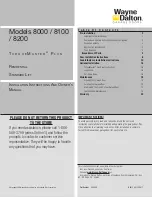
12
12
Detent Pin adjustment - Continued
(see Diagram 12 on page 9 of Drawings of Installation, Use and Maintenance manual)
Tools Needed:
Screw Driver (Flat
Head)
A.) If the motor does not pivot down, or pivots down only partially, the detent pin (2g) is set too hard. Using a
flat head screwdriver, turn the detent pin (2g) anti-clockwise (counter clockwise) in 1/4 turn increments.
Operate the door to confirm each adjustment. Repeat procedure until motor pivots to full down position
when the door is completely closed.
B.) If the motor pivots down prematurely (before the door is completely closed) or if the motor is “slapping”
too aggressively against the top of the door, the detent pin (2g) is set too soft. Using a flat head screwdriver,
turn the detent pin (2g) clockwise in 1/4 turn increments. Operate the door to confirm each adjustment.
Repeat procedure until motor pivots to full down position when the door is completely closed.
13
Custom Settings (Only available with Wall Station)
(see Diagram 13 on page 10 of Drawings of Installation, Use and Maintenance manual)
Tools Needed:
None
CUSTOM PET POSITION:
Normal install routine sets pet open height to approximately 200 mm above floor. Pet opening height may be changed to open
anywhere between 200 mm and 750 mm above floor. To change automatic pet opening height, perform the following
procedure:
1. After completion of normal install routine, with door in closed position, disconnect door from opener with emergency
disconnect. Manually raise door to a height more than 300 mm above floor. Manually lower door to the desired pet position
opening height and re-engage emergency disconnect.
2. Simultaneously depress pet button (2h) and up/down button (2d) on Wall Station. The opener will beep once. The pet button
is now programmed to automatically open door to this custom height.
NOTE
: activation of normal install routine always sets pet position opening to default 200 mm height.
For function of the pet button, see Page 13, under wall station operation.
14
Tests
(see Diagram 14 on page 10 of Drawings of Installation, Use and Maintenance manual)
Tools Needed:
None
CONTACT OBSTRUCTION TEST:
After installing opener, door must reverse when it contacts a 50 mm high object on floor. To test proper operation:
1. Activate door to fully open position by pressing Wall Station up/down button or programmed Transmitter button.
2. Place a 50 mm high object on floor centrally located between right and left hand vertical track.
3. Activate door to closed position by pressing Wall Station up/down button or programmed Transmitter button; upon contacting
a solid object, door should stop, then reverse direction within (2) seconds and travel to fully open position.
NOTE
: if opener fails to pass this test, remove the 50 mm object and repeat Performing Install Routine in step 11 making sure
door is in the fully closed position before beginning. If problem persists contact an authorized, qualified door system service
representative.
OPENER OBSTRUCTION TEST:
After installation, ensure that the opener will not allow door to open when the door is loaded with a weight of 20 kg, attached in
the center of the bottom edge of the door.
15
CE / Serial Number Label
(see Diagram 15 on page 10 of Drawings of Installation, Use and Maintenance manual)
Tools Needed:
None
When all steps of the installation are completed and door is ready for use, remove the strip covering the CE / Serial number
label (2i). This label is located on the end stile (2j) of the door’s lock section (2k).
The limited Warranty is conditioned upon exact compliance with the manufacturer’s notes of installation, Use and maintenance
manual.









































